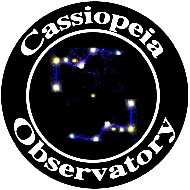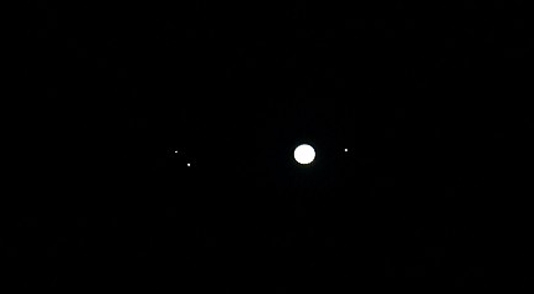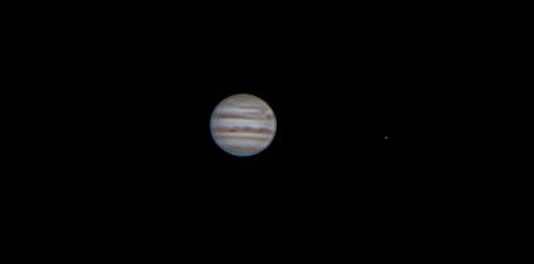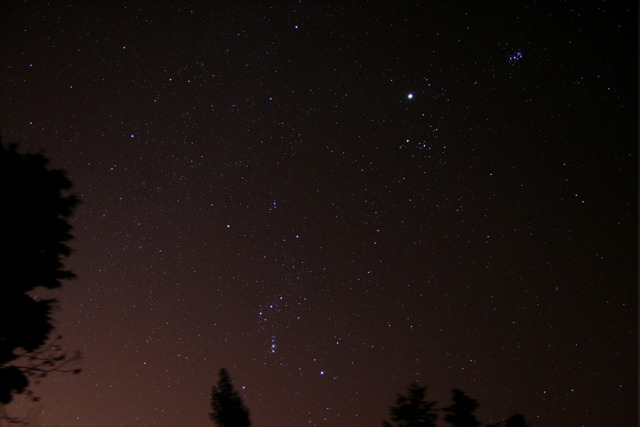
ASTROPHOTOGRAPHY - TIPS
Last updated: 17 April 2013
This page documents astrophotography comments, tips, and photos. Contributions welcome. Be certain to see the other articles on the main Astrophotography page.
Subject: CCD , Filter wheel and f3.3 reducer no focus Sent: Saturday, April 13, 2013 12:27:35 From: simon wihl (simon_wihl@hotmail.com) I have an ETX 125 PE and have attached a DMK camera to a filter wheel and then the Meade f3.3 focal reducer to the back port of the telescope but don't seem to be able to focus. I have taken out the filter wheel and all is ok. Does the addition of the wheel put the CCD out of the focal range of the instrument or is there another way to do this ? Regards. Simon.Mike here: There is limited focus travel on the ETX, so it is not surprising that the addition of a filter wheel along with the SCT adapter + focal reducer will not focus. You could try a focal reducer designed for the ETX (if you can find one).
Subject: Cannot Focus DSLR Camera on ETX 90 Sent: Monday, March 18, 2013 15:55:02 From: GoodmanFandM (goodmanf@q.com) As always I enjoy your site and the wonderful images you post, from your Cassiopeia, observatory. I am always amazed at what the IPhone ( and other cameras) can image, and the great care and patience you apply to your craft. Now to my issue. I have a Pentax Kx DSLR camera, with the 18-55mm and 55-300mm Pentax lenses. I have tried, unsuccessfully, obtain focus, with the camera attached to the eyepiece holder (no eyepiece), and using either camera lens. Although I have the Meade 1244 Electric Focuser, I cannot get focus in either direction of focus travel. I temporarily removed the electric focuser and used the large brass gear to attempt focus. All to no avail. When I turn the gear fully CW (to the mechanical stop), I get closer to a possible focus, but I would need much more travel CW (not possible). I have tried both Landscape and Macro modes, as well as full manual focus. Nothing brings the images (The Moon or Jupiter) into focus. My homemade adapters have a depth of about 1 inch between the camera lens and the eyepiece holder. I have tried many lens magnification ranges (both lenses trying the full range) and no improvement. What suggestions might you have? Thank you, as always-Fred and Happy Holidays, coming up soon.Mike here: From your description it sounds like you are making a common mistake: using the camera lens when you shouldn't. See the article "Astrophotography Types" on the Helpful Information: Astrophotography page on my ETX Site to learn more about imaging with cameras.
And:
Thanks again, Mike, for the speedy reply. I guess I must use either eyepiece projection(no camera lens?) or afocal (both camera lens and telescope eyepiece?). I also have a Panasonic Lumix FZ-47 mega zoom camera. It has too much magnification (even at the lowest magnifications), to use with the afocal method (way too much vignetting) and since the lens is fixed, I am out of luck, also with eyepiece projection. Blessing to you and your family.Mike here: With removable lens cameras you can do prime focus, eyepiece projection, or afocal photography. However, not all cameras will focus with all adapters on all telescopes, so your mileage may vary.
Subject: Meade Focal Reducer and ETX90 for Photography
Sent: Tuesday, March 5, 2013 07:49:03
From: santiago.vallee@mdlz.com (santiago.vallee@mdlz.com)
My gear list is as follows.
ETX90
#64 T Adapter
Canon 1000D (In US is the Rebel XT... I think)
And the list of gear continues, but these are the parts intervening on the issue.
I am starting up on astrophotography. Last January I was able to take
prime focus photos of the Jupiter occultation (unguided, but excited for
the success!), so during the summer I decided to go for wide field
photos with my camera lenses and tripod.
I wanted to return to the prime focus and read that a Focal Reducer is a
must, but I could not find much info regarding the compatibility with
the ETX90. I see that MEADE offers an ETX to SCT back cell thread
adapter, but I am afraid that I will need to change the #64 for a SCT T
Adapter...
Any insight in this regard will be appreciated.
BTW: I loved the Dr Craig ETX TuneUp articles, that I consolidated all
the text and photos (as well the scopetronix parts as annexes) in a PDF.
Let me know if you want to have it, and I can forward it to you for
inclusion in your site.
Thank you so much for your help and for the ongoing effort to maintain
the ETX Site for all of us.
Best regards!
Santiago Miguel Valle
Mike here: First, a suggestion. Mounting a camera at the rear port of the ETX creates two significant problems: balance and interference from the ETX base. If you mount at prime focus using the eyepiece port you avoid these problems. I use the OPT Camera Adapter (see the Accessory Reviews: Astrophotography page). As to a focal reducer, there are several (older) ones discussed on the Accessory Reviews: Astrophotography page. Some ETX focal reducers will mount at the rear port and some like an eyepiece. A focal reducer will make the ETX a faster optical system and yield a wider field-of-view (FOV). The wider FOV will reduce the image scale, making tracking errors less noticeable (but still present, depending on how long an exposure you do).
And:
Thanks Mike. Will check the "eyepiece port" options then. Best! Santiago Miguel Valle
Subject: Jupiter's moons Sent: Thursday, January 10, 2013 12:17:10 From: Terry Godfrey (terry.godfrey@mypostoffice.co.uk) Having had some recent success using the Meade LPI and its software, I thought I'd try acquiring a short video clip of Jupiter on my Canon 600D and simply using Registax to align and stack the individual frames.

The overexposed image above (flipped to give an erect image) clearly shows 3 moons, however from http://www.nakedeyeplanets.com/jupiter.htm#jupmoons at the time the video was made (18:06hrs UT on 9th January 2013 at Oxford UK) the fourth moon, Europa, should have been visible emerging from behind and to the left of Jupiter. There was still no sign of Europa 30 minutes later when it clouded over. A better image (flipped) was obtained in the same way but using a barlow x2 on my Meade 125EC. Video frame exposure was set to 1/30" sec and ISO 1600. Some 1200 frames were aligned and stacked using Registax.

From the nakedeyeplanet.coms website, Io is just visible to the right but there is no sign of Europa to the immediate left of Jupiter - Callisto and Ganymede were off screen to the left. The quality seems much better using the Canon EOS 600D when compared to the LPI. Any idea why the website's data did not agree with my actual sighting or perhaps I have misinterpreted the site's data? Regards Terry Godfrey, Oxford UKMike here: The web site data agrees with Pocket Universe on my iPhone for about the same time:

And:
Thanks Mike. I screwed the levels right up in Photoshop and indeed, a faint spot did appear in the "right" place. Regards Terry Godfrey
Subject: USB and HBX extension cables Sent: Friday, January 4, 2013 12:18:16 From: Terry Godfrey (terry.godfrey@mypostoffice.co.uk) Thanks for the advice (My Astro-photography question posted on 01/04/13) I will try 10 metre extensions to both USB and HBX cables which should be long enough. I note that a straight 10 metre CAT cable used in place of the Meade cable would kill the Autostar due to the pin connections not being reversed so I will use a 10 metre CAT cable and an inline connector with the existing Meade HBX cable to maintain pin connections. Regards Terry Godfrey
And an update:
The 10 metre #497 HBX extension cable and 10 metre LPI USB extension cable appear to work fine!
Subject: Astro-photography Tips page Sent: Thursday, January 3, 2013 04:00:15 From: Terry Godfrey (terry.godfrey@mypostoffice.co.uk) I was interested in your communication with Robert (29th December 2012) re. general night sky photography on the Astro-photography Tips page In December 2012 I had hoped to catch Geminid meteor trails on camera but instead of leaving the shutter open for several minutes with a static camera I decided to piggyback my DSLR on my polar tracking Meade 125EC using an intervalometer to repeatedly take 2 minute exposures in the hope of catching a meteor against a reasonably bright star field rather than star streaks. Unfortunately I didn't catch any meteors before the camera lens dewed over but thought Robert might be interested in the result of a typical 2 minute tracked exposure.

Photo details: Canon EOS600D, 18mm @f4, ISO 400, exposure 2 minutes. Orion is in centre with Jupiter above the Hyades and to left of the Pleiades The reddening in the sky is from the city lights of Oxford. On a separate topic, I have been trying some astro-photography with the LPI on my Meade 125EC. Finding it rather cold sitting beside my laptop next to the scope, what is the maximum extension I could attach to the LPI USB cable and also the 497 handset control cable to enable me to view the LPI image and make tracking adjustments from indoors? Below is my first attempt at Jupiter

Regards Terry GodfreyMIke here: USB cable lengths can run very long, but there is a limit and a power issue. Do a search for "USB length" on the ETX Site and you'll get several pages that discuss the LPI USB cable length. The HBX cable can also be very long; see the article "Long AutoStar Cable" on the Helpful Information: AutoStar Info page.
Go to the May-December 2012 Astrophotography - Tips page.
Go to the January-April 2012 Astrophotography - Tips page.
Go to the October-December 2011 Astrophotography - Tips page.
Go to the July-September 2011 Astrophotography - Tips page.
Go to the January-June 2011 Astrophotography - Tips page.
Go to the April-November 2010 Astrophotography - Tips page.
Go to the January-March 2010 Astrophotography - Tips page.
Go to the April-December 2009 Astrophotography - Tips page.
Go to the January-March 2009 Astrophotography - Tips page.
Go to the May-December 2008 Astrophotography - Tips page.
Go to the February-April 2008 Astrophotography - Tips page.
Go to the July-December 2007 Astrophotography - Tips page.
Go to the January-June 2007 Astrophotography - Tips page.
Go to the October-December 2006 Astrophotography - Tips page.
Go to the July-September 2006 Astrophotography - Tips page.
Go to the April-June 2006 Astrophotography - Tips page.
Go to the January-March 2006 Astrophotography - Tips page.
Go to the November-December 2005 Astrophotography - Tips page.
Go to the September-October 2005 Astrophotography - Tips page.
Go to the July-August 2005 Astrophotography - Tips page.
Go to the May-June 2005 Astrophotography - Tips page.
Go to the March-April 2005 Astrophotography - Tips page.
Go to the January-February 2005 Astrophotography - Tips page.
Go to the October-December 2004 Astrophotography - Tips page.
Go to the July-September 2004 Astrophotography - Tips page.
Go to the April-June 2004 Astrophotography - Tips page.
Go to the January-March 2004 Astrophotography - Tips page.
Go to the 2003 Astrophotography - Tips page.
Go back to the Astrophotography Page.
Go to the ETX Home Page.